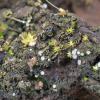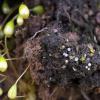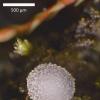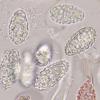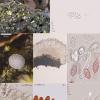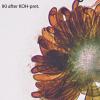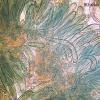
02-01-2026 17:43
MARICEL PATINOHi there, although I couldn't see the fruitbody, I

01-01-2026 18:35
Original loamy soil aside a artificial lake.The co

31-12-2025 19:27
Collected from loamy soil, at waterside (completel

30-12-2025 16:44
Pascal DucosBonjour,Une anamorphe rose stipitée, très nombre

30-12-2025 17:14
 Bernard CLESSE
Bernard CLESSE
Bonjour à toutes et tous,Pourriez-vous aider Albe
White ascolichen (?) on burnt ground
Enrique Rubio,
18-03-2019 12:06
These minute, white, sessile, pruinose, hemisphaerical, neither applanate nor cupulate, 0.5-0.7 mm in diameter, grew among Ceratodon purpureus and algae on sandy burnt soil.
The thick-walled, strongly dextrinoid asci which may appear to be bitunicate, have an irregular apical dehiscence as in some Mniaeceia species (white arrow). No conspicuous paraphyses I have seen. Ascospores coarsely verrucose.
Some idea for it?
Many thanks again
Enrique
Hans-Otto Baral,
18-03-2019 12:16

Re : White ascolichen (?) on burnt ground
Hi Enrique
superb. The asci are hemiamyloid, not dextrinoid, and I am quite sure this belongs in Vezdaea. No idea about a name, I have no key at hand.
Zotto
superb. The asci are hemiamyloid, not dextrinoid, and I am quite sure this belongs in Vezdaea. No idea about a name, I have no key at hand.
Zotto
Enrique Rubio,
18-03-2019 12:21
Re : White ascolichen (?) on burnt ground
Hi Zotto
Could you explain to me the differences between hemiamyloid and dextrinoid?
Could you explain to me the differences between hemiamyloid and dextrinoid?
Hans-Otto Baral,
18-03-2019 12:27

Re : White ascolichen (?) on burnt ground
This is quite easy:
dextrinoid is a red reaction that is seen in both Lugol and Melzer (better in the latter), and if you pretreat with KOH it is still red.
hemiamyloid is only red in Lugol, and if you KOH-pretreat, the reaction is blue.
In your Vezdaea surely the asci will react blue after KOH.
Besides, I never met an ascus with an outer wall reacting dextrinoid.
Zotto
dextrinoid is a red reaction that is seen in both Lugol and Melzer (better in the latter), and if you pretreat with KOH it is still red.
hemiamyloid is only red in Lugol, and if you KOH-pretreat, the reaction is blue.
In your Vezdaea surely the asci will react blue after KOH.
Besides, I never met an ascus with an outer wall reacting dextrinoid.
Zotto
Enrique Rubio,
18-03-2019 12:43
Hans-Otto Baral,
18-03-2019 12:50

Re : White ascolichen (?) on burnt ground
Did you also test MLZ for whether the red appears?
Enrique Rubio,
18-03-2019 13:08
Antonio Gómez-Bolea,
18-03-2019 14:48
Re : White ascolichen (?) on burnt ground
Yes is Vezdaea
V. rheocarpa fits well with your sample.
Hans-Otto Baral,
18-03-2019 15:25

Re : White ascolichen (?) on burnt ground
I suppose your first KOH-pretreatment was not strong enough. In the second I see only blue ascus walls. Higher KOH-concentrations or a short heating over a flame assure that the chemical conversion takes place.
MLZ without KOH should be negative, I think the orange is due to plasma staining by the colour of iodine.
MLZ without KOH should be negative, I think the orange is due to plasma staining by the colour of iodine.
Enrique Rubio,
18-03-2019 15:48
Re : White ascolichen (?) on burnt ground
Thanks, Zotto and Antonio.
I will look for V. rheocarpa.
I will look for V. rheocarpa.
Enrique Rubio,
18-03-2019 16:12
Re : White ascolichen (?) on burnt ground
By the way
Has someone the invalid description of Vezdaea rheocarpa Poelt & Döbbeler, Bot. Jb. 96(1-4): 347 (1975)?
Many thanks in advance
enrirubio@asturnatura.com
Has someone the invalid description of Vezdaea rheocarpa Poelt & Döbbeler, Bot. Jb. 96(1-4): 347 (1975)?
Many thanks in advance
enrirubio@asturnatura.com




